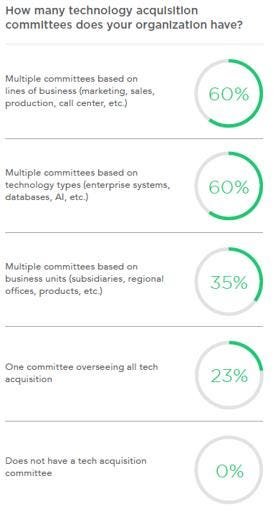At Forbes Research we study how leadership, innovation and strategy are evolving in this era of rapid digital transformation. One area undergoing major change: enterprise technology purchasing.
As companies scale AI across the enterprise and technology touches every function and role, new questions have emerged: Who actually decides what technology companies invest in – and has that changed? What role do enterprise purchasing committees play today, and what objectives are guiding their decisions?
To explore these questions, and others, we conducted the Forbes Enterprise Technology Purchasing Report, which surveyed more than 1,000 global executives across various functions. All respondents are involved in decision-making for technology purchases.
Our research finds a major shift in purchasing influence underway. Five years ago, most technology decisions were owned by the CIO, even as departments like marketing and HR gained budget authority. Today, the landscape is far more complex.
Technology has long outgrown its roots as a back-office function. It’s now the foundation of enterprise strategy, shaping how organizations operate, compete and grow. Today’s technology investments signal where organizations are headed, who holds influence and how leaders are thinking about risk, growth and accountability.
This year’s survey makes it clear that the stakes are higher than ever, shaped by economic uncertainty and the accelerating pace of digital transformation. As a result, technology purchase decisions are increasingly shared by both technology and business leaders. This distribution of responsibility highlights the importance of governance, alignment and cross functional leadership.
Leaders across the enterprise recognize that smart technology investments build resilience and future-proof their organizations. While only 14% of companies reported double-digit growth in tech budgets in 2024, 57% expect to exceed that threshold in 2025, with artificial intelligence and machine learning leading the way. But it’s not just about how much companies are spending, it’s about who is making these decisions and why. We’ve observed several shifts:
The Rise of Business-Led Tech Investment & Committee Driven Decision Making
Today, 59% of technology purchases are led by IT departments, but in just three years, the balance is expected to shift, where 53% of technology purchases will be driven by business units, with IT accounting for 47%. This shift is about more than who holds the budget, it also reflects an evolution in technology strategy.
Technology purchasing decisions are not made by a single individual. Committee approval is now the top deciding factor for tech investment. The data show
Technology Acquisition Committees
that organizations have multiple technology acquisition committees. In this year’s survey, 60% of respondents say they have multiple committees based on lines of business, and 60% report having multiple committees based on technology types. All respondents confirmed they have a technology acquisition committee in some form.
Regional differences are striking. In North America, 72% of organizations have business-unit based committees compared to 66% with technology-based ones. Business-led purchasing committees are 21% more common in North America than in EMEA, and 26% more common than in APAC. This suggests a strong alignment between tech investments and outcomes like growth, customer experience and innovation – areas often owned outside of traditional IT – for North America based decision makers.
In conversations I’ve had with C-suite leaders across industries, it’s clear this shift is well underway. Technology strategy is a team sport—one that demands shared language, urgency and accountability.
Future Proofing: Cybersecurity, Regulations and the Economy
Enterprise leaders are under pressure to future-proof their organizations against a convergence of external forces. Of these, cybersecurity stands out as the most urgent and complex challenge.
In our survey, 83% of enterprise technology buyers cited increased cybersecurity threats as their top external factor shaping tech purchase decisions over the next five years. That concern is showing up in budget priorities: cybersecurity is the second-highest planned investment area for 2025 following only AI and machine learning. As organizations adopt more advanced technologies and automate critical workflows, cybersecurity is at the center of brand reputation, regulatory risk and boardroom accountability. The bar is high: 84% of business leaders strongly agree that data privacy and security are essential criteria in tech purchasing decisions.
Leadership Lessons from Tech Accelerators
To understand what sets the most effective leaders apart, we examined a cohort we call “Tech Accelerators”. These are CIOs and CTOs at companies with 5%+ in year-over-year revenue growth. This group represents 5% of the research sample.
Their leadership approach is collaborative, confident and focused on growth. Compared to their peers, Tech Accelerators are:
● 20% less likely to say they lack a clear technology strategy roadmap.
● 10% less likely to say they have difficulty integrating technologies into legacy systems.
● 7% less likely to say there is difficulty aligning the technology value proposition with overall business goals.
What is the impact? These leaders enable their organizations to build competitive advantage by fostering cultures of innovation. Their agility – rooted in clear priorities, and fast, aligned decision making – positions them for growth.
In an environment defined by accelerating AI innovation, rising cybersecurity threats and economic volatility, enterprise leaders face pressure to adapt in real time.
The most innovative leaders are using technology to drive growth and long-term resilience. That’s what the future of leadership looks like.
One force increasingly shaping these decisions, and deserving closer attention, is sustainability. I’ll explore that in a follow-up.
Read more about the Enterprise Technology Purchasing Report here and take a quiz here.







